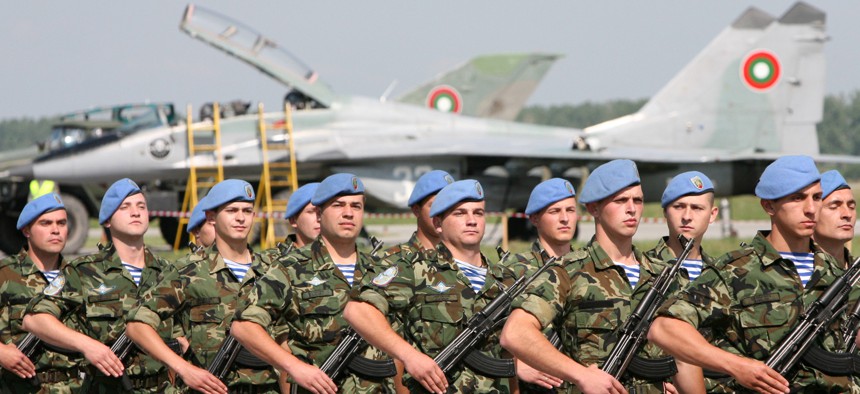
Bulgarian special forces soldiers parade walk in front of the Mig-29 jet fighter, during an open air show in the military air base of Graf Ignatievo east of the Bulgarian capital Sofia, Friday, June, 1, 2007. ap photo/petar petrov
To Strengthen NATO, Congress Must Help End Its Reliance On Russian Equipment
Here are three steps to remove a dangerous dependence on the alliance’s primary threat.
It is time for NATO members to finally replace their aging fleets of Soviet-Russian military equipment, and Congress can help do just that.
After World War II, as the Soviet Union turned from ally to adversary, the United States helped rebuild the broken militaries of western Europe by providing more than $50 billion (in today’s dollars) in military aid to bolster the members of the new NATO alliance. There was no similar American investment after the fall of communism in NATO’s new eastern members. Doing so seemed unnecessary. After all, the United States was trying to integrate Russia into Europe, not deter it.
Unfortunately, the threat posed by Moscow has returned. While the prospect of conflict remains low, Russia’s 2014 invasion of Ukraine and hostility toward the Alliance has once again made deterring Russian aggression NATO’s core mission.
Yet the Alliance has a severe Achilles heel. The limited defense capabilities of eastern NATO members presents a soft underbelly for an expansionist and revanchist Russia. NATO’s newest eastern members, many former Warsaw Pact states, continue to operate increasingly decrepit Soviet and Russian equipment, including fighter jets, frigates, and tanks.
Related: We Need a NATO/EU for Cyber Defense
Related: French MOD Rebukes Trump Administration for Arms-Sales Focus
Related: Toward ‘Fort Trump’: US Makes Poland a ‘Serious Robust Offer’
This is not only a military vulnerability; it creates a dependence on Russia. This has facilitated an absurd situation where eastern NATO members—the very ones on the front lines of potential hostilities with Russia—rely on Moscow to keep their equipment operational, as they have to buy spare parts and components from the sanctioned Russian defense industry. This means that NATO needs Russia’s defense industry to ensure that NATO forces can deter or counter Russian forces.
NATO is not oblivious to this problem. But its eastern members lack the money to broadly overhaul their armed forces, leaving them with a dilemma: continue to pour money into old equipment and risk U.S. sanctions from continued purchases from Russia, or blow the budget on new, advanced NATO-made systems. Many of these states are inclined to keep the old junk working as best they can.
With all the talk of Europe needing to increase defense spending, small marginal increases would barely make a dent in efforts recapitalize their forces. These countries should spend more, but they don’t have that much more to spend. Left on their own, it will take decades for eastern NATO members to replace whole fleets of equipment. It is like someone on an entry-level salary trying to buy a house in all-cash, with no mortgage. To buy the house, they are going to need a loan.
Congress must step in. One innovative way forward is for lawmakers to support the creation of an Eastern European Security Investment Initiative that could provide willing NATO partners with a mix of loans and grant assistance for rebuilding their aging forces.
The last ten years has seen a dramatic expansion in regionally targeted U.S. security assistance efforts, such as in Southeast Asia, Ukraine, and Africa. But these are all grant assistance programs; replacing whole fleets of equipment would be an order of magnitude more expensive. Furthermore, while Eastern Europe’s NATO members are not financial powerhouses, they are largely middle-income democracies that have the capacity to spend more on defense. To provide loans, the State Department could use its Foreign Military Financing program, which currently only provides grant assistance, but used to be a lending program and retains the authority to provide defense loans even if it rarely does.
But to lend money, one has to have money to lend. And the State Department doesn’t have any money. This program would probably need roughly $5 billion in initial funding. The $6 billion currently in the FMF budget is all spoken for. (Most of the funds go to Israel, Jordan, and Egypt.) While $5 billion is no insignificant amount, it is roughly on par with spending on the Pentagon’s European Deterrence Initiative. Congress could also provide funds in a variety of ways: increase State’s budget, include money in the overseas contingency operations account, or just direct the Pentagon to retransfer funds from its $700 billion budget to the State Department.
While providing loans can be risky, the U.S. would charge interest, meaning the U.S. might even profit from these loans. As a result, this new effort wouldn’t be an assistance initiative – it would be an investment initiative. There is also a successful precedent. In the early 2000s, the Bush administration provided a loan to Poland to finance the acquisition of F-16s so they could retire their MiG fighters. Poland paid the United States back with interest.
To incentivize countries to take part, the United States should also provide the equivalent of a first-time home buyer tax credit. Congress could allocate an additional $500 million to the State Department to work with recipients to reduce loan origination costs, help with down payments, and reduce overall cost. However, Congress should also require recipient countries demonstrably increase their overall defense spending to meet the NATO two percent spending target.As NATO convenes in Washington next month to commemorate the alliance’s 70th anniversary, the U.S. Congress, which has already taken a number of bipartisan steps to reaffirm U.S. commitment to NATO, should seize the opportunity to ensure a strong and prosperous transatlantic alliance for another seven decades. To do so, Congress should finally help our eastern NATO allies get rid of their decrepit Soviet equipment once and for all.



